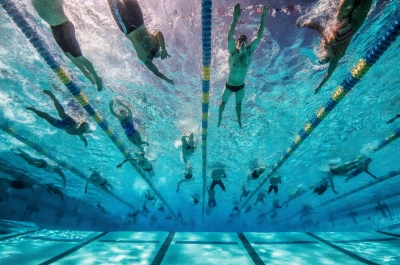What's in the Swimming Pool?

By Lisa Jancarik
According to a Water Quality and Health Council survey, about one in five Americans view getting out of the public pool to enter the restroom as an extra step. Apparently, urine in the pool is an ongoing problem with swimming pools, and it gets worse from there. The average swimmer also brings microbes from spit (eight million per drop), hands (five million) and hair (ten million) to the water. Plus, one or two cans of sweat per swimmer add to the mixture.
What’s worse, the average swimmer contributes at least 0.14 grams of fecal matter to the pool within the first fifteen minutes of entry. Don’t just blame the kids, either. When adults skip a pre-swim shower with soap – as seven in ten swimmers do – the E. coli commonly associated with human feces sloughs off. In properly chlorinated conditions, these germs last only about ten minutes. However, hardier pathogens like Giardia and Cryptosporidia survive longer; forty-five minutes and ten days, respectively.
Recreational Water Illnesses (RWIs) caused by swallowing germs from swimming pools are on the rise over the past twenty years according to the Centers for Disease Control and Prevention (CDC). The same agency reported in a 2008 study that nearly one in eight swimming pools in thirteen states seriously violated public health standards and needed to be closed immediately. The most common type of RWI is diarrhea, although skin, eye, ear and respiratory infections occur.
What’s a Swimmer to Do?
Chlorine and pH are the first line of defense against pathogens in pool water. Chlorine levels should be 1.0 to 4.0 parts per million, while pH should range between 7.2 and 7.8. If a pool smells strongly of chlorine, then beware. The odor indicates that the chlorine is busy neutralizing organic matter. The urine from twenty percent of swimmers is consuming the chlorine intended to kill germs – chlorine ions aren’t picky about where their nitrogen comes from. Also, a pool with an excessively alkaline pH diminishes the chlorine’s ability to mop up organics. These levels fluctuate throughout the day depending on how many swimmers have been in the pool, so the CDC encourages pool owners and managers to check levels very frequently.
An average adult swimmer swallows about one tablespoon of pool water, and children consume 2.5 tablespoons. That quantity makes a more than adequate dose to sicken the unwary. Good pool hygiene tips include:
- Skip the pool entirely if you have diarrhea. In fact, skip for two weeks after the diarrhea stops if diagnosed with Cryptosporidia.
- Avoid the pool if it smells strongly of chemicals.
- Shower first and wash your hands often. Also wash the kids, especially the diaper area.
- Take frequent bathroom breaks for the kids and don’t changethe diapers by the pool.